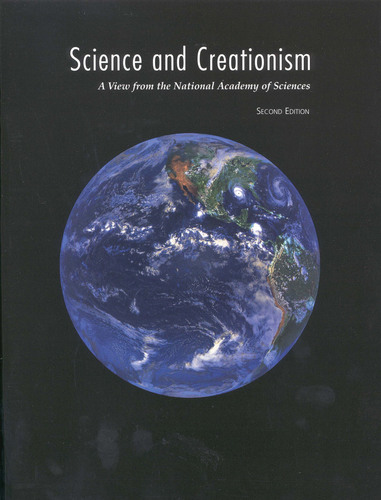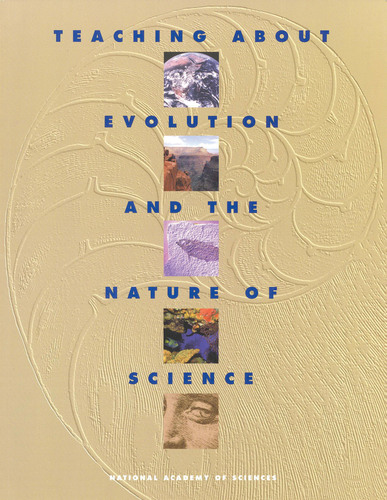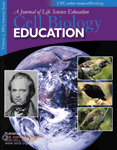From the National Academies: Teaching the Science of Evolution
This article differs from our past columns in Cell Biology Education. Rather than providing an overview of selected education activities at the Academies, this article focuses on the Academies' efforts to address challenges to the teaching of evolution in the nation's public schools. We describe the nature of the problem and how we have joined with others in the life and physical science communities to confront it. We also point out what you can do, if and when similar challenges emerge where you live.
THE ISSUES
I was talking with someone in vision physiology the other day and he told me, “Wow, I had no idea that the subject was so rigorous. I had no idea that you actually did experiments.” We have a serious public-relations problem. People don't realize this is real science.
This quote from evolutionary biologist David Endler was reported by Jonathan Weiner (1994) in The Beak of the Finch, his Pulitzer Prize-winning book about modern evolutionary science. The “public relations” problem that he reports extends well beyond scientists. In the Twentieth Century, the teaching of some form of “creation science” alongside evolution was promulgated in virtually every state (e.g., Lerner, 2000; Moore, 2002a). It has been examined in numerous federal courts and three times by the U.S. Supreme Court.1 In all cases, the Court ruled that “creation science” was, in fact, the promotion of one religious view rather than science, and thus unconstitutional to teach as science in public schools (National Research Council, 1998; Moore and Miksch, 2003). As a result, those opposed to the teaching of evolution have attempted to have evolution removed from state or district science curricula because of a purported “weakness” in the theory, espousing the idea that living systems are too complex to have evolved through natural processes and thus must have resulted from the working of some kind of“ intelligent designer.”2 Supporters of “Intelligent Design” are now attempting to have this perspective included in science standards and curricula in increasing numbers of states and local school districts (Moore, 2002b).
1Details of cases adjudicated in federal courts and the U.S. Supreme Court are provided by National Research Council (1998) and Matsumora (1995).
2Proponents of Intelligent Design emphasize that the “designer” is not necessarily a deity, thereby claiming that this view of origins is not religious and therefore not prohibited by Supreme Court rulings. However, a number of Intelligent Design publications and Web sites are clearly associated with groups that promote a particular religious perspective of the origins of life on earth and the evolution of the earth itself.
Although national in its scope and consequences, challenges to teaching evolution or the promotion of the teaching of one form or another of creationism typically is considered a state or local issue; participation in the debate by national scientific organizations often is viewed with great skepticism or disdain by the officials embroiled in the controversy. Thus, while the National Academies has sometimes taken public stands in various states and, on rare occasions, in specific counties or school districts, we have pursued a multifaceted approach to fit the specific situation in which we have been asked to provide assistance. The Academies' participation in these ongoing debates has involved primarily three types of activities:
Publishing reports to help teachers and school officials better understand the scientific evidence for evolution;
Producing position papers or joint statements with organizations such as the American Association for the Advancement of Science and the National Science Teachers Association; and
Working directly with members of the National Academy of Sciences, the National Academy of Engineering, and the Institute of Medicine who live in a state where a challenge to teaching evolution has been raised, urging them to become involved as citizens and offering suggestions about how they might do so most effectively. We wish to encourage all scientists to play a role in supporting the teaching of evolution in public schools.
NATIONAL ACADEMIES PUBLICATIONS ON EVOLUTION, EDUCATION, AND THE NATURE OF SCIENCE
The National Science Education Standards (National Research Council, 1996) include a series of standards for teaching, content, and assessment of student knowledge about evolution of life and the earth. The Standards lay the groundwork for such understanding through developmentally appropriate concepts from the earliest grades, specifying increasingly sophisticated concepts in the higher grades.
Science and Creationism: A View from the National Academy of Sciences, 2nd ed. (National Academy of Sciences, 1999) (Figure 1), is a short booklet written for the general public by prominent evolutionary biologists who are members of the National Academy of Sciences and by leading science educators. It presents a concise overview of the scientific evidence supporting biological evolution, and it outlines what is known concerning the origins of the universe, earth, and life on this planet.
Published in 1998, Teaching About Evolution and the Nature of Science (TAENS; Figure 2) was the National Academy of Science's first book written primarily to help teachers in grades K-12 understand the kinds of research and the science that underlie the massive body of evidence supporting the theory of evolution. TAENS also describes how the scientific approach differs from other ways of knowing about the origin of the earth and life on this planet. It provides a series of “Frequently Asked Questions About Evolution and the Nature of Science,” suggests activities and instructional materials that teachers can use in their classrooms, and offers an historical overview of attempts to challenge the teaching of evolution in our nation's schools and the court cases that helped to define what can and cannot be taught in science classes.
Evolution in Hawaii: A Supplement to Teaching About Evolution and the Nature of Science (Olson, 2004) is, in essence, a “case study” that presents the scientific evidence for evolution of life in the Hawaiian Islands, focusing on the adaptive radiations observed there in the picture-winged drosopholids and the silverswords. This book also emphasizes the geological evidence for the appearance of the various islands of Hawaii and the changes in these plants and animals that occurred in association with the emergence of those islands. A laboratory exercise written by high school science teachers enables students to understand the likely evolutionary relationships among 14 species of Hawaiian picture-winged drosopholids based on actual data about changes in their salivary gland chromosomes. These data are then correlated with the evidence on the age of the various islands of Hawaii, thereby enabling students to discuss how the various species of flies on different islands are related to each other.
The National Academies Press is establishing a special Web site that will enable high school science teachers to obtain free copies of the three reports on evolution education until the supply is exhausted. The Web site ( http://www.nap.edu/hawaii) is being announced in newsletters and other publications of scientific and education organizations. All three publications are also available on the Web (see References).
POSITION PAPERS AND JOINT STATEMENTS
Over the past decade, the National Academy of Sciences has issued a series of individual and joint position statements about evolution education. Highlights of two position papers are detailed below. The complete text for all statements by the President of the National Academy of Sciences is available online at http://www.nationalacademies.org/president/alberts.html.
Joint Statement from the Presidents of the National Academy o Sciences, American Association for the Advancement of Science, and the National Science Teachers Association Regarding the Kansas Science Education Standards (1999).3
In September 1999 a law firm representing the Kansas State Board of Education sought permission to reprint “selected portions” of the National Science Education Standards (National Research Council, 1996), Benchmarks for Science Literacy (American Association for the Advancement of Science, 1993), and Pathways to the Science Standards (National Science Teachers Association, 1997). These organizations had originally given tentative permission to the writing team from Kansas to incorporate portions of these publications into the revised Kansas Science Education Standards. However, the standards that were approved by the Kansas State Board of Education in August contained substantive revisions (not discussed with the writing team) that removed any mention of scientific views about the origins of the universe, life on earth, and evolutionary explanations for speciation (standards about changes within species—so-called“ microevolution”—were retained). As a result, the National Academies Press denied copyright permission to Kansas, thereby preventing their claim that the revised standards were based in large part on the National Science Education Standards. The presidents of the three organizations (Bruce Alberts, Stephen Jay Gould, and Emma Walton) issued a joint statement dissociating the national standards documents produced by their organizations from the revised state standards, with a lengthy description of their reasons for doing so. This joint statement received wide publicity in Kansas and across the nation. Following a critical grassroots effort by scientists and other concerned citizens in the state, the members of the Board who had caused this tumult by altering the work of the writing team were replaced in an election more than a year later by candidates who vowed to vote to reverse their actions. Reinstatement of the standards as originally proposed by the writing team was one of the first acts of the newly constituted Board, and the three scientific organizations issued a joint statement congratulating the Board for doing so.4
3Available at http://www4.nationalacademies.org/news.nsf/isbn/s09231999?OpenDocument.
A Statement on an Ohio Lesson Plan Challenging the Theory of Evolution (2004)
Early in 2004, the Ohio State Board of Education was scheduled to vote on adopting revised science standards, including optional lesson plans that were designed to help teachers implement the new standards in their classrooms. Scientists and citizens in Ohio became concerned about several of these lesson plans that would encourage teachers to offer aspects of Intelligent Design in science classrooms. A member of the National Academy of Sciences from Ohio brought these issues to our attention. One of these lesson plans for tenth grade, “Critical Analysis of Evolution,” was especially troubling:
The lesson defines “theory” in a way that makes it sound much less rigorous than the way scientists define the term.
As with the revised Kansas standards, this lesson plan uses the terms“ microevolution” (defined by Intelligent Design proponents as genetic changes within existing species) and “macroevolution” (defined by proponents of Intelligent Design as genetic changes that lead to speciation) in ways that make them seem like two distinct processes. In fact, evolutionary theory makes no such distinction; the processes that lead to changes within species, when accumulated over time, also can give rise to new species.
The lesson plan points teachers and students to six Web sites, the first of which are from Intelligent Design and religious-oriented groups.
Tenets of Intelligent Design also had been introduced into other lessons dealing with the age of the earth, the theory of continental drift, and the composition of the sun. Bruce Alberts sent a letter outlining the concerns of scientists.5 As of March 2004, the Ohio Board had nevertheless voted to include “Critical Analysis of Evolution” as part of the approved set of instructional materials. The American Civil Liberties Union is contemplating a lawsuit to challenge this action. Additional information about this continuing controversy is available from Ohio Citizens for Science.6
5Available at http://www.ohiosci.org/AlbertsFeb092004.htm.
6Available at http://ecology.cwru.edu/ohioscience/.
Figure 1. Cover of Science and Creationism, 2nd ed. (National Academy of Sciences, 1999).
Figure 2. Cover of Teaching About Evolution and the Nature of Science (National Academy of Sciences, 1998).
WORKING WITH LOCAL SCIENTISTS AND ENGINEERS
In 2002, the Cobb County (Georgia) School Board voted to place disclaimers about biological evolution in its biology textbooks and proposed the adoption of a policy stating that “discussion of disputed views of academic subjects is a necessary element of providing a balanced education.” While there are numerous controversies in science and technology that might be discussed, the policy included the “origin of the species” as its only example, a classic tactic for introducing Intelligent Design or other variants of creationism to provide “balance.”
Last year, the Texas State Board of Education held hearings on whether to approve a policy that would require publishers to revise “factually incorrect” information about evolution science in high school science textbooks before they are approved for purchase and use in Texas schools. Specifically, 11 highly regarded high school biology textbooks were subject to being removed from the approved list because they did not point out“ weaknesses” in scientific theories; the only theory that was pegged as “weak” was evolution. Because textbook publishers tailor their products to meet the requirements of the three states that maintain textbook adoption lists (California, Texas, and Florida), the inclusion of such disclaimers or removal of the offending materials would have had repercussions for the entire nation.
Earlier this year, the State Superintendent of Schools for Georgia unilaterally decreed that the word “evolution” would be stricken from the proposed revisions to the science standards and replaced with the euphemism “biological change over time.” The Georgia standards had been adopted almost verbatim from the American Association for the Advancement of Science's Benchmarks (1993), but the proposed revisions had multiple blocks of text excised that focused on scientific explanations for the origins of life and the earth (e.g., natural selection, long geological history of the earth, plate tectonics).
In each of these and several other cases, a member of the National Academy of Sciences or another scientist living in those states brought the controversies to our attention. The presidents of the National Academy of Sciences, National Academy of Engineering, and Institute of Medicine then sent messages to their Academy members living in those states that described the controversy and offered suggestions about how they might become directly involved (see below).
What have the results been? In the Texas textbook controversy, Dr. Alfred Gilman, Nobel Laureate and a member of the National Academy of Sciences at the University of Texas Southwestern Medical Center in Dallas, decided to become directly involved. Dr. Gilman recruited 16 of his Academy colleagues (three of whom are also Nobel Laureates) to cosign an op-ed piece that appeared in the Dallas Morning News a few days before the Texas Board of Education was to vote. As a result of such efforts, the policy was not approved.
Similarly, in Georgia, coordinated pressure from scientists and engineers from that state (and also from business leaders and former President Jimmy Carter) resulted in the Superintendent's reversing her decision and returning the word “evolution” and evolutionary concepts to the state's standards; these standards are still available for public comment and will be voted on by the Georgia Board of Education in several months. The Cobb County School Board originally voted to uphold the proposed language but, threatened by a lawsuit from the American Civil Liberties Union, changed its position in 2003 to unambiguously promote the teaching of evolution in its schools.7
7For more information, see http://www.ncseweb.org/resources/news/2003/GA/771_cobb_county_clarifies_teach_o_1_13_2003.asp.
THE CONTROVERSY DOES NOT ABATE: WAYS FOR CELL BIOLOGISTS TO BECOME INVOLVED IN LOCAL OR STATE CONTROVERSIES
According to the National Center for Science Education,8 challenges to the teaching of evolution are presently under way in Alabama, Montana, Missouri, Ohio, and Oklahoma. Those who raise challenges to the teaching of evolution or demand time for consideration of alternatives to evolution are well organized and, if history is any indicator, will likely become active in increasing numbers of states and localities in the future.
8For more information, see http://www.natcenscied.org/.
The following suggestions for combating such challenges have been sent to members of the Academies and are offered here for all scientists who wish to become involved.
Send e-mails or letters to members of appropriate school boards that state your position clearly and without technical jargon. A list of the members of the Board of Education for your district, county, or state and their e-mail addresses are usually available via the Internet.
Write an editorial or op-ed piece to local and statewide newspapers spelling out your position on this issue. Such articles need to present the issues in ways that the general public can appreciate. Highly technical arguments are not likely to be as persuasive.
Given the organizational skills, experience, and political astuteness of those who promote creationism and Intelligent Design, it is suggested that you NOT agree to enter into direct debates with the proponents if you have not been involved with such activities before.
Cell and molecular biologists have provided some of the most compelling evidence to support the theory of evolution and should therefore be among those who raise their voices the loudest to support science curricula that help students understand the processes of evolution. As scientists, we also should make it our responsibility to present the evidence for biological evolution to all of our students, especially in introductory courses. Most students who enroll in our introductory courses will use them as their terminal courses in science. At least some of those students will go on to careers as teachers or as public servants who will be asked to make decisions about whether to allow nonscientific approaches to teaching evolution to appear in science curricula. It is our responsibility to equip them with the knowledge and understanding of science that they will need to confront such challenges.
As Endler noted, the study of evolution is indeed “real science” (in Weiner, 1994).



